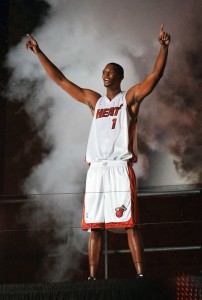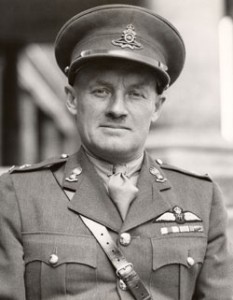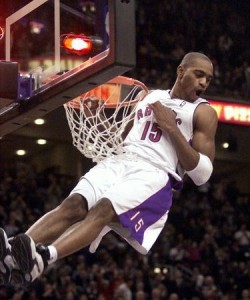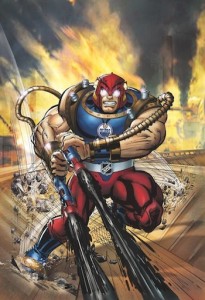Why is Chris Bosh going to be booed tonight?
Fans of the Toronto Raptors and Chris Bosh, the former star of the team, have been on a collision course since the National Basketball Association’s schedule was released two months ago.
Ever since Bosh announced he was signing with the Miami Heat, fans have been chomping at the bit to heckle and jeer him when he returns to Toronto. The wait is finally over, as Bosh’s Miami Heat will be at the Air Canada Centre tonight.
“I’m on another team,’’ he said to the Toronto Sun on Tuesday. “I would like it (to be liked) because that’s like a fairy tale ending or beginning, but that might not be the case.
“I’ll be ready for anything.”
Bosh can hope all he want, but he is going to be booed and heckled every time he steps in Toronto for the rest of his career. He will be subjected to as much vitriol as Vince Carter and Tracy McGrady are even though they’re years removed from their time on the Raptors.
Sadly, Bosh will probably never understand why he’s now the target of so much scorn in Toronto.
Ironically, the reason for the hatred is the same reason why he left: he doesn’t understand the character of the city.
He doesn’t understand that, ultimately, Toronto is a conservative place.
I don’t mean conservative in the modern, Glenn Beck, Republican sense, but the classical, small-c libertarian way, with an emphasis on individuality, entrepreneurship and, above all else, work ethic.
Founded by Governor John Graves Simcoe in 1793, the city historically stood in contrast to its Gallic cousin to the east, Montreal.
Largely inhabited by Protestants of British decent until the 1950s, Toronto’s early civic life focused on being loyal citizens to the crown, devoted members of their church and especially constructive members of the business world.
Those three characteristics earned Toronto nicknames likes “the Queen City” and “Toronto the Good”. Jokes about being able to shoot a cannon down Yonge Street on a Saturday night without hitting anyone were common. It was a staid, serious place.
Over time, monarchism and religiousness have faded and Toronto has become a more cosmopolitan, multicultural place with a vibrant nightlife. But that dedication to working hard and getting things done has remained at the core of the city.
The serious, stoic demeanour of Torontonians is often interpreted amongst other Canadians, perhaps fairly, as aloofness or even arrogance. There’s a coldness to how people carry themselves in Toronto, although defenders of the city would probably call it “walking with purpose”.
That indifference translates to the business world: It doesn’t matter who you are or where you’re from, as long as you put your nose to the grindstone and work hard, there’s a place for you in Toronto.
It’s that businesslike attitude has made Toronto the most multicultural city on Earth. It’s what makes Ontario’s capital the home of North America’s oldest continuously running Orangeman’s parade, but also allows Toronto to host one of the world’s largest LGBT Pride festivals every summer – the two seemingly contradictory events are held just weeks apart.
That spirit of efficiency and industriousness is what inspired Peter Ustinov to say “Toronto is New York run by the Swiss.”
Toronto’s workmanlike approach to, well, everything, has influenced the city’s sporting culture as well.
Like most things in Toronto’s sporting history it all starts with Conn Smythe.
The founder and long-time owner of the Maple Leafs favoured players who played a tough, relentless style of hockey. His motto of “If you can’t beat ‘em in the alley you won’t beat them on the ice” shaped the identity of the franchise, and set it apart from the free-wheeling finesse play of the rival Montreal Canadiens.
Smythe also set the tone for fan behaviour in Toronto, enforcing a strict dress code for fans at Leafs games. There’s a famous story that a wealthy couple rewarded their maid with their seasons tickets for the night. The morning after the game Smythe called the couple’s home, threatening to revoke their passes if anyone in their seats wasn’t wearing a shirt and tie or a proper Sunday dress, because the maid and her date hadn’t met Smythe’s high standards.
As a result, Torontonians have little interest in flashy athletes or raucous crowd behaviour. They want to quietly cheer on their teams and reward the players who work the hardest, not necessarily the ones with the best numbers.
Take the current roster of the Blue Jays as an example.
The most enduringly popular baseball player in Toronto this past decade is utility infielder John McDonald, despite his career .239 batting average.
I promise you that when the team’s line up is announced on opening day this spring the crowd reaction for perennial bench warmer McDonald will rival that of reigning home run king Jose Bautista.
Why? Because when McDonald does play, he puts his heart out on the field. A terrible batter, the 36-year-old veteran has won the love of Jays fans by never quitting on a play, and happily volunteering to do whatever the team needs him to do, including pitch relief or help out as the bullpen catcher.
Similarly, the Leafs have had a lengthy list of players renowned for their intensely physical style of play that has earned them the adoration of fans, even though their offensive numbers are far inferior to their contemporaries.
Players like Darcy Tucker, Tie Domi, Wendel Clark and Doug Gilmour will forever be deified in Toronto not for any goals they scored or any particularly outstanding play, but for the way they punished anyone who dared step on the ice against the Leafs.
Even when a truly gifted and talented player suits up for a Toronto franchise, it takes that same kind of hard-working, detail-oriented approach to win the fans’ devotion. Fortunately for sports fans in the city, the two best players to play in Toronto in the past 20 years are Roy Halladay and Mats Sundin, the quietest and most stoic athletes you can imagine.
This brings us to the Raptors and why poor Bosh is going to have hate, and possibly garbage, poured on him at the Air Canada Centre tonight.
It has little to do with loyalty – after all, both Halladay and Sundin left Toronto for greener pastures and they’re still beloved – and everything to do with how he left.
Whether they can articulate it or not, Torontonians are incensed by Bosh’s apparent rejection of their values.
Like Vince Carter before him, Bosh has left the Raptors to seek fame and fortune, to be flashy and find the spotlight of endorsement deals and American media attention. He left the cold, hard streets of Toronto for the glitzy nightlife of South Beach.
Worse yet, Bosh spent his last games with the Raptors sitting on the bench, nursing an injury. That is a cardinal sin to Torontonians: he was lazy.
Torontonians can understand, even appreciate, Halladay and Sundin leaving to win championships with better clubs - being rewarded for your hard work makes perfect sense to the city. But leaving for nightclubs and the easy life of sunny Florida? That is anathema.
It’s a shame, too. Bosh had showed so much promise when he was first drafted by the Raptors. Feature stories and interviews with the young rookie talked about how much work he was planning on doing in the off season. He openly discussed how he had to consume thousands of calories a day to bulk up for the more physical play of the NBA. Bosh liked to read. He was a computer science major in university.
In other words, he was perfect for Toronto.
Particularly after the disaster that was Carter’s time with the Raptors.
After all, Carter was a flashy style-over-substance player who briefly won the hearts of Raptors fans with the franchise’s deepest playoff run to date, only to blow it all by going to his university’s graduation ceremony instead of – that’s right – focussing on the task at hand and giving 100% to his team.
But slowly, the love affair between Bosh and Toronto soured. His charming videos of him working out became more self-aggrandizing and egocentric. It was less about industry and more about creating a brand.
Bosh had the negative example of Carter to try and avoid, but was also surrounded by positive role models like Matt Bonner, Jerome Williams, Morris Peterson and Jose Calderon. They’re all players who aren’t nearly as talented as Bosh, but who work hard on and off the court and were rewarded with the love and appreciation of the fans.
Instead, Bosh has opted to make a cameo on Entourage, film navel-gazing documentaries on getting his first tattoo and make over-the-top appearances with James and Dwyane Wade announcing how many championships they’re going to win with the Heat.
Bosh left because he felt like Toronto wasn't the place for him to reach the level, not just on the court, but off of it. He was right. It's no place for someone seeking fame, because they'll never find it here. The city spurns superstars.
Raptors fans, the supporters of any sports team in this city, will always favour the quiet, hard-working bench warmer over the flashy star with all the merchandise. Bosh's vision just couldn't line up with what the city demands of its sports heroes. That's not his fault, or Toronto's, it's just the way it's meant to be.
Unfortunately for Bosh, all this adds up to one thing: Toronto is going to show him no mercy. Not necessarily because he betrayed the city’s trust or because he is a bad player or because Raptors fans are particularly spiteful, but because he’s turned his back on the values the city holds most dear. Effort. Hustle. Hard work.
Chris Bosh is going to be booed tonight and for the rest of his career because he rejected the core value that governs behaviour in Toronto. He unknowingly struck at the city’s core principle, and Raptors fans will be unable to forgive him for that.
What is the best team in Toronto?
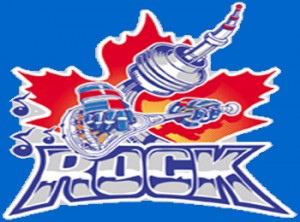 Toronto sports fans are lucky – they live in one of the few cities in North America to have a professional sports team in all four major leagues.
Toronto sports fans are lucky – they live in one of the few cities in North America to have a professional sports team in all four major leagues.
Well, okay, there isn’t really a National Football League team here, but the Buffalo Bills play two games a season at the Rogers Centre and there are the Toronto Argonauts, historically the Canadian Football League’s most successful team. Football is definitely covered in Canada's largest city.
But I digress. Toronto has eight professional sports teams, on a par with, or better than, the 14 American cities that have teams in the NFL, National Basketball Association, Major League Baseball and the National Hockey League.
Unfortunately, this creates a weird competition amongst the teams as they vie for fans attention. I was reminded of this weeks ago when a friend of mine from senior school posted on Facebook “So glad the Leafs suck more than the Raps. At least the Raps have upside”.
Of course, this was before the Raptors embarked on a Cavaliers-esque 13-game losing streak, but the comment got me wondering: what is the best team in Toronto? Which team does the best job of representing a city spoiled for choice?
Here are all of the city’s professional sports franchises, in order of winning percentage over the past two years.
| Team | This season | Last season | Cumulative |
| Rock | .667 (4-2)* | .562 (9-7)† | .615 |
| Blue Jays | .525 (85-77) | .463 (75-87) | .494 |
| Marlies | .470 (24-20-7)* | .413 (33-35-12) | .442 |
| Nationals‡ | .250 (3-9) | .583 (7-9) †¥ | .417 |
| Maple Leafs | .426 (23-26-5)* | .366 (30-38-14) | .396 |
| Raptors | .269 (14-38)* | .488 (40-42) | .379 |
| Argonauts | .500 (9-9-0) † | .167 (3-15-0) | .336 |
| Toronto FC | .300 (9-13-8) | .333 (10-11-9) | .317 |
Notes: * - Season currently underway.
† - Made the playoffs.
¥ - Won championship.
‡ - It was announced in the offseason that the Toronto Nationals have moved to the bustling metropolis of Hamilton, Ont., for 2011.
What’s most apparent in this chart is that it’s good to be a fan of lacrosse in Toronto. Especially if you live in the western part of the Greater Toronto Area, since Major League Lacrosse’s Toronto Nationals – the most recent champions in the city – are moving to nearby Hamilton.
But if you want to see a Toronto-based team do well in the regular season and go deep in to the postseason, you’d better pick up the nuances of lacrosse. The Rock are the best team in the NLL this year after losing a close game in the league championship last season.
Further, six of Toronto’s last nine championships have come from lacrosse teams, with the Rock contributing five and the Nationals bringing home the Steinfeld Cup two summers ago. The other three are all thanks to the Toronto Argonauts winning the Grey Cup in 1996, 1997 and 2004.
It’s also worth noting that attendance is seemingly unaffected by a team’s success.
Most Torontonians would immediately twig to the fact that the Maple Leafs, the city’s fifth best team, remain the most popular franchise while the Blue Jays – ranked second – had serious attendance problems last summer.
But what I find most striking is that Toronto FC, the team with the most passionate fans, has the worst record of Hogtown’s professional sports franchises.
In any event, I think this is an interesting exercise that would test perceptions of Toronto’s sports teams. Tell me: were there any surprises on this chart for you?
Sky Sports has the right idea but the wrong reason
Famed soccer analyst Andy Gray grabbed headlines in the United Kingdom and abroad when he was fired by Sky Sports last week for sexist remarks made about a female linesman Sian Massey before a English Premier League match she was scheduled to help officiate.
Although Sky Sports’ decision wasn’t necessarily motivated by high-minded ideals about the place of women in professional sports, they undoubtedly made the right move.
Gray’s comments (see video above) compounded an off-air incident in December of 2010 where he asked fellow Sky Sports commentator Charlotte Jackson “Charlotte, can you tuck this down here for me?” after lifting up his belt buckle.
Yes, Sky Sports has absolutely done the right thing by getting Gray off the airwaves. It’s just a shame that the leading sports network in Britain and Ireland hasn’t taken a more philosophical approach to the dispute.
I believe that sports – like other aspects of culture, whether they be literature, music, films, whatever – have the power to create a more inclusive society by inspiring people to greater and greater heights.
Any kind of discrimination, even if it’s coming out of the mouth of a beloved figure like Gray, damages that inclusivity and limits the full potential of sports to motivate people.
After all, what kind of message is that sending? “You can grow up to be as successful as these stars, that is, unless you’re a woman. Then you can’t understand the offside rule.”
What’s more, including women and visible minorities strengthens soccer – or any sport for that matter.
If a linesman like Massey really is good enough to work in the EPL, then she should. If she’s replacing an official who was becoming a little old or too slow or was inconsistent in his calls, then her presence will improve the quality of the games.
Isn’t that what the EPL, Sky Sports and the fans of soccer want? Higher-quality matches?
I’m confident that Sky Sports dismissed Andy Gray to avoid a lawsuit and to improve the optics of his on camera gaffe. But that dismissal should have more positive effects in the long run than they had ever imagined.
Although Gray's dismissal does send the message that there is no room in professional soccer for discrimination, Sky Sports should have been even more decisive when they released him from the network and emphasized how important it is to them to create a more inclusive culture in sports.
A funny thing happened on the way to the video feature…
EDIT: The Globe and Mail has now uploaded my video on lacrosse goaltender pads. You can view it here.
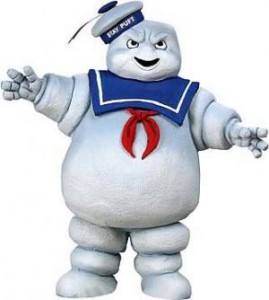 A few weeks ago Neil Davidson, my editor at the Canadian Press, suggested I do a video feature story on the padding an indoor lacrosse goaltender wears. We agreed that having a professional lax goalie put on all his gear and demonstrate how it protects him would be perfect for a short, two-minute piece.
A few weeks ago Neil Davidson, my editor at the Canadian Press, suggested I do a video feature story on the padding an indoor lacrosse goaltender wears. We agreed that having a professional lax goalie put on all his gear and demonstrate how it protects him would be perfect for a short, two-minute piece.
As a result, I spent last Saturday morning in the bowels of the Air Canada Centre interviewing Pat Campbell, the back-up goaltender of the National Lacrosse League's Toronto Rock. Pat was incredibly nice and a great interview. We shot some really good footage of him putting on his gear and explaining each piece - including some funny asides about his personal superstitions - as well as a general dicussion in the stands about being a goaltender.
Neil then suggested I turn my extra quotes from Pat into a written feature story. After all, most of the Canadian Press' clients are smaller dailies across Canada that don't carry video on their websites.
Both the video and the article were released late yesterday, with the story popping up in several places online, including TSN.ca and the Winnipeg Free Press. I'm still searching for the video online, but I'm sure it'll pop up at some point.
"There’s a simple reason why an indoor lacrosse goalie looks like, in the words of the Toronto Rock’s Pat Campbell, the Stay Puft Marshmallow Man.
A lacrosse shot can go faster than the average hockey slapshot — and usually is fired from closer range.
“You just can’t be afraid of the ball,” says Campbell, an 11-year veteran of the National Lacrosse League. “I often have to convince myself that it’s a rubber ball, not a bullet." - Kitchener-Waterloo Record, Feb. 2nd 2011.
The NHL’s Guardian Project is a misstep
The National Hockey League’s All-Star Weekend has come and gone, generally creating a positive buzz for professional hockey in North America.
The All-Star Fantasy Draft, where captains Eric Staal and Nicklas Lidstrom selected their superstar teams schoolyard style, was a huge success, averaging 600,000 viewers in the United States.
Unfortunately, the lingering product from the gala event in Raleigh N.C. is the Guardian Project, the NHL’s misguided attempt at drawing in today’s youth.
The Guardian Project is a marketing campaign where legendary comic book creator Stan Lee designs super heroes based off the names of all 30 NHL franchises.
Sounds good in theory, but in practice the idea plays out like a super villain’s hare-brained scheme. Stan Lee + comic books + hockey teams + ???? = world domination.
In other words, it’s not very well thought out.
The NHL Guardians are problematic from their very conception. First, Stan Lee simply doesn’t have as much cultural cache as he once did. After all, he hasn’t had a monthly title since Ravage 2009 in the early 1990s. You know, when the Guardian Project’s target demographic was still years away from being born.
Second, the characters themselves are lame. Witness Chris Sims of ComicsAlliance epic takedown: The Ten Most Insane Characters From Stan Lee's 'NHL Guardians'.
Many of the characters seem to be based on a brief skimming of each franchise’s Wikipedia page. Important details like the military heritage of the Chicago Blackhawks and Toronto Maple Leafs aren’t touched on at all.
Most importantly, the NHL’s marketing department is once again playing away from the game’s strengths.
Hockey is one of North America’s oldest sports, with the NHL’s Original Six predating any National Basketball Association franchise, only a handful of National Football League teams and most Major League Baseball clubs.
It’s a disgrace that the Montreal Canadiens, a franchise that is over 100 years old and a cornerstone of Quebecois society, is being represented by the likes of this:
But campaigns like Project Guardians relies on trendy thinking that makes the NHL seem newer than the Arena Football League or other shaky niche sports.
Seriously – the Tampa Bay Storm of the Arena Football League predate the Tampa Bay Lightning by five years. The Charlotte Rage were created and folded before the Carolina Hurricanes moved from Hartford, Conn. The list goes on and on.
Commissioner Gary Bettman and the rest of the powers that be at the NHL have to learn that if they really want to make inroads in the Sun Belt, they need to educate and inform their new fanbase about the rich history and tradition of the game, not disregard it.
Otherwise, the NHL comes off as just the latest in a long line of failed sporting enterprises.
That’s why innovations like the All-Star Fantasy Draft and the Winter Classic have been so successful: because they are reminiscent of the history and tradition of hockey.
It’s also why the NHL’s Guardians Project was a dreadful misfire: it glosses over one of the most appealing aspects of hockey.
